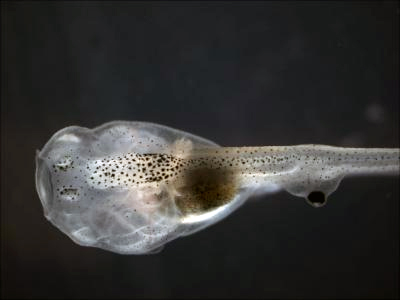Scientists Create Tadpoles That See from Their Tails
The latest addition to the strange menagerie of engineered animals is a group of blind tadpoles that see out their tails. The findings, published in the Journal of Experimental Biology in February, provide further proof of the nervous system’s remarkable capacity to rewire itself.

information, even if not connected directly to the brain.
Researchers painstakingly transplanted eyes from donor tadpoles onto the torso and tails of animals that had had their own eyes surgically removed. About 20 percent of the engineered animals showed they could actually use those eyes, even when they weren’t directly connected to the brain. The animals swam away from red light, which they had previously been taught was associated with an unpleasant zap of electricity.
For the eyes to work, they did have to connect to the animal’s spinal cord. But they didn’t need to integrate into the sophisticated machinery that makes up the visual system.
Researchers say the ability to bypass the brain has implications for tissue engineering and efforts to treat blindness and other sensory disorders because they suggest new therapies may not need to involve the brain circuits typically involved in vision. That could prove especially helpful for people who have damage to crucial parts of the eye or brain.
Keep Reading
Most Popular
Large language models can do jaw-dropping things. But nobody knows exactly why.
And that's a problem. Figuring it out is one of the biggest scientific puzzles of our time and a crucial step towards controlling more powerful future models.
How scientists traced a mysterious covid case back to six toilets
When wastewater surveillance turns into a hunt for a single infected individual, the ethics get tricky.
The problem with plug-in hybrids? Their drivers.
Plug-in hybrids are often sold as a transition to EVs, but new data from Europe shows we’re still underestimating the emissions they produce.
Stay connected
Get the latest updates from
MIT Technology Review
Discover special offers, top stories, upcoming events, and more.